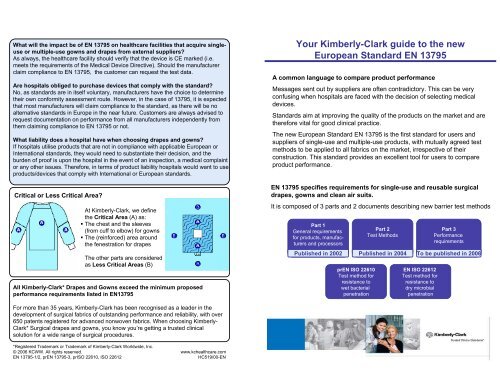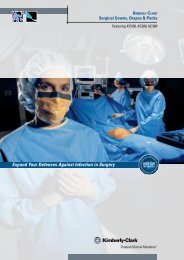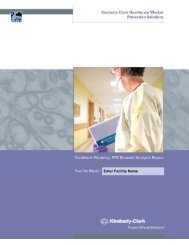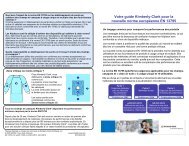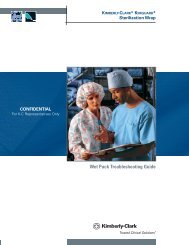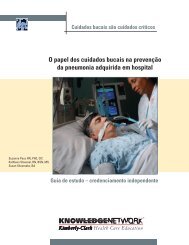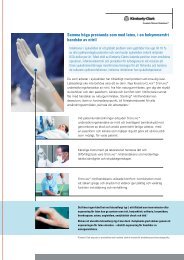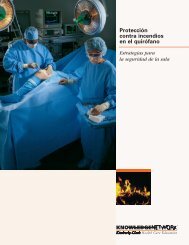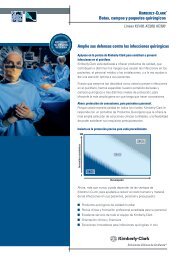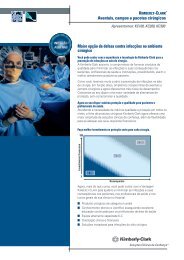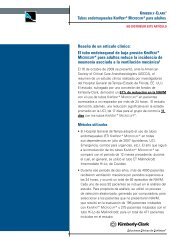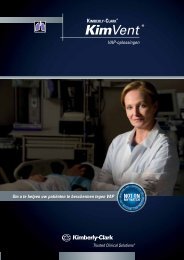Your Kimberly-Clark guide to the new European Standard EN 13795
Your Kimberly-Clark guide to the new European Standard EN 13795
Your Kimberly-Clark guide to the new European Standard EN 13795
Create successful ePaper yourself
Turn your PDF publications into a flip-book with our unique Google optimized e-Paper software.
What will <strong>the</strong> impact be of <strong>EN</strong> <strong>13795</strong> on healthcare facilities that acquire singleuse<br />
or multiple-use gowns and drapes from external suppliers?<br />
As always, <strong>the</strong> healthcare facility should verify that <strong>the</strong> device is CE marked (i.e.<br />
meets <strong>the</strong> requirements of <strong>the</strong> Medical Device Directive). Should <strong>the</strong> manufacturer<br />
claim compliance <strong>to</strong> <strong>EN</strong> <strong>13795</strong>, <strong>the</strong> cus<strong>to</strong>mer can request <strong>the</strong> test data.<br />
Are hospitals obliged <strong>to</strong> purchase devices that comply with <strong>the</strong> standard?<br />
No, as standards are in itself voluntary, manufacturers have <strong>the</strong> choice <strong>to</strong> determine<br />
<strong>the</strong>ir own conformity assessment route. However, in <strong>the</strong> case of <strong>13795</strong>, it is expected<br />
that most manufacturers will claim compliance <strong>to</strong> <strong>the</strong> standard, as <strong>the</strong>re will be no<br />
alternative standards in Europe in <strong>the</strong> near future. Cus<strong>to</strong>mers are always advised <strong>to</strong><br />
request documentation on performance from all manufacturers independently from<br />
<strong>the</strong>m claiming compliance <strong>to</strong> <strong>EN</strong> <strong>13795</strong> or not.<br />
What liability does a hospital have when choosing drapes and gowns?<br />
If hospitals utilise products that are not in compliance with applicable <strong>European</strong> or<br />
International standards, <strong>the</strong>y would need <strong>to</strong> substantiate <strong>the</strong>ir decision, and <strong>the</strong><br />
burden of proof is upon <strong>the</strong> hospital in <strong>the</strong> event of an inspection, a medical complaint<br />
or any o<strong>the</strong>r issues. Therefore, in terms of product liability hospitals would want <strong>to</strong> use<br />
products/devices that comply with International or <strong>European</strong> standards.<br />
Critical or Less Critical Area?<br />
At <strong>Kimberly</strong>-<strong>Clark</strong>, we define<br />
<strong>the</strong> Critical Area (A) as:<br />
• The chest and <strong>the</strong> sleeves<br />
(from cuff <strong>to</strong> elbow) for gowns<br />
• The (reinforced) area around<br />
<strong>the</strong> fenestration for drapes<br />
The o<strong>the</strong>r parts are considered<br />
as Less Critical Areas (B)<br />
All <strong>Kimberly</strong>-<strong>Clark</strong>* Drapes and Gowns exceed <strong>the</strong> minimum proposed<br />
performance requirements listed in <strong>EN</strong><strong>13795</strong><br />
<strong>Your</strong> <strong>Kimberly</strong>-<strong>Clark</strong> <strong>guide</strong> <strong>to</strong> <strong>the</strong> <strong>new</strong><br />
<strong>European</strong> <strong>Standard</strong> <strong>EN</strong> <strong>13795</strong><br />
A common language <strong>to</strong> compare product performance<br />
Messages sent out by suppliers are often contradic<strong>to</strong>ry. This can be very<br />
confusing when hospitals are faced with <strong>the</strong> decision of selecting medical<br />
devices.<br />
<strong>Standard</strong>s aim at improving <strong>the</strong> quality of <strong>the</strong> products on <strong>the</strong> market and are<br />
<strong>the</strong>refore vital for good clinical practice.<br />
The <strong>new</strong> <strong>European</strong> <strong>Standard</strong> <strong>EN</strong> <strong>13795</strong> is <strong>the</strong> first standard for users and<br />
suppliers of single-use and multiple-use products, with mutually agreed test<br />
methods <strong>to</strong> be applied <strong>to</strong> all fabrics on <strong>the</strong> market, irrespective of <strong>the</strong>ir<br />
construction. This standard provides an excellent <strong>to</strong>ol for users <strong>to</strong> compare<br />
product performance.<br />
<strong>EN</strong> <strong>13795</strong> specifies requirements for single-use and reusable surgical<br />
drapes, gowns and clean air suits.<br />
It is composed of 3 parts and 2 documents describing <strong>new</strong> barrier test methods<br />
Part 1<br />
General requirements<br />
for products, manufacturers<br />
and processors<br />
Part 2<br />
Test Methods<br />
Part 3<br />
Performance<br />
requirements<br />
Published in 2002 Published in 2004 To be published in 2006<br />
pr<strong>EN</strong> ISO 22610<br />
Test method for<br />
resistance <strong>to</strong><br />
wet bacterial<br />
penetration<br />
<strong>EN</strong> ISO 22612<br />
Test method for<br />
resistance <strong>to</strong><br />
dry microbial<br />
penetration<br />
For more than 35 years, <strong>Kimberly</strong>-<strong>Clark</strong> has been recognised as a leader in <strong>the</strong><br />
development of surgical fabrics of outstanding performance and reliability, with over<br />
650 patents registered for advanced nonwoven fabrics. When choosing <strong>Kimberly</strong>-<br />
<strong>Clark</strong>* Surgical drapes and gowns, you know you’re getting a trusted clinical<br />
solution for a wide range of surgical procedures.<br />
*Registered Trademark or Trademark of <strong>Kimberly</strong>-<strong>Clark</strong> Worldwide, Inc.<br />
© 2006 KCWW. All rights reserved. www.kchealthcare.com<br />
<strong>EN</strong> <strong>13795</strong>-1/2, pr<strong>EN</strong> <strong>13795</strong>-3, prISO 22610, ISO 22612<br />
HC519/00-<strong>EN</strong>
BARRIER<br />
LINTING<br />
Resistance <strong>to</strong> Dry Microbial Penetration (<strong>EN</strong> ISO 22612)<br />
Objective: determine <strong>the</strong> ability of <strong>the</strong> dry<br />
fabric <strong>to</strong> resist penetration of particles<br />
carrying micro-organisms.<br />
Method: <strong>the</strong> test fabric is placed in a<br />
container with talc powder contaminated<br />
with Bacillus subtilis. Any talc that<br />
penetrates <strong>the</strong> fabric is captured on a<br />
sedimentation plate underneath and<br />
incubated.<br />
Measure: number of colonies formed<br />
after incubation, expressed as log 10.<br />
Test Performance Requirements<br />
(Log 10 (CFU))<br />
Gown<br />
Drape<br />
<strong>Standard</strong><br />
Perf.<br />
C<br />
-<br />
-<br />
LC<br />
≤2<br />
≤2<br />
C<br />
-<br />
-<br />
High<br />
Perf.<br />
LC<br />
≤2<br />
≤2<br />
Cleanliness - Particulate Matter & Linting (ISO 9073-10)<br />
Cleanliness – Particulate Matter<br />
Objective: estimate linting of <strong>the</strong> fabric in<br />
a dry state, prior <strong>to</strong> twisting and<br />
compressing.<br />
Method: fabric is placed in a chamber<br />
and number particles are calculated<br />
Measure: number of particles from 3µm<br />
<strong>to</strong> 25µm, as an index for Particulate<br />
Matter (IPM) expressed as log 10.<br />
Test Performance Requirements<br />
(IPM)<br />
Gown<br />
Drape<br />
<strong>Standard</strong><br />
Perf.<br />
C LC<br />
≤3,5 ≤3,5<br />
≤3,5<br />
≤3,5<br />
C<br />
≤3,5<br />
≤3,5<br />
High<br />
Perf.<br />
LC<br />
≤3,5<br />
≤3,5<br />
Resistance <strong>to</strong> Wet Microbial Penetration (pr<strong>EN</strong> ISO 22610)<br />
Objective: determine a fabric's resistance<br />
<strong>to</strong> penetration of bacteria in a liquid while<br />
being subjected <strong>to</strong> mechanical rubbing.<br />
Method: <strong>the</strong> test fabric is subjected <strong>to</strong><br />
material contaminated with<br />
Staphylococcus aureus suspension. If<br />
penetration occurs, bacteria will collect<br />
on <strong>to</strong> an agar surface and be incubated<br />
Measure: number of colonies formed<br />
after incubation, expressed in Barrier<br />
Index (BI)<br />
Test Performance Requirements<br />
(BI)<br />
Gown<br />
Drape<br />
<strong>Standard</strong><br />
Perf.<br />
C LC<br />
≥2,8 -<br />
≥2,8<br />
-<br />
C<br />
6,0<br />
6,0<br />
High<br />
Perf.<br />
LC<br />
-<br />
-<br />
Linting<br />
Objective: estimate linting of <strong>the</strong> fabric in<br />
a dry state, after twisting and<br />
compressing<br />
Method: <strong>the</strong> same fabric sample is<br />
twisted and compressed<br />
Measure: number of particles from 3µm<br />
<strong>to</strong> 25µm generated after <strong>the</strong> twisting and<br />
compressing, expressed as log 10 of <strong>the</strong><br />
count value<br />
Test Performance Requirements<br />
(Log 10 (lint count))<br />
Gown<br />
Drape<br />
<strong>Standard</strong><br />
Perf.<br />
C LC<br />
≤4,0 ≤4,0<br />
≤4,0<br />
≤4,0<br />
C<br />
≤4,0<br />
≤4,0<br />
High<br />
Perf.<br />
LC<br />
≤4,0<br />
≤4,0<br />
STR<strong>EN</strong>GTH<br />
Resistance <strong>to</strong> Liquid Penetration (<strong>EN</strong> 20811)<br />
Bursting Strength – Dry & Wet (<strong>EN</strong> 13938-1)<br />
Objective: estimate <strong>the</strong> resistance of<br />
fabrics <strong>to</strong> liquid penetration by water<br />
under constantly increasing hydrostatic<br />
pressure.<br />
Method: One side of <strong>the</strong> fabric sample is<br />
subjected <strong>to</strong> purified water pressure<br />
which is increased at a constant rate until<br />
leakage appears on <strong>the</strong> o<strong>the</strong>r side of <strong>the</strong><br />
fabric sample.<br />
Measure: The head height results are<br />
recorded in centimeters of water<br />
pressure on <strong>the</strong> fabric sample.<br />
Test Performance Requirements<br />
(cm H 2 O)<br />
Gown<br />
Drape<br />
<strong>Standard</strong><br />
Perf.<br />
C LC<br />
≥20 ≥10<br />
≥30<br />
≥10<br />
High<br />
Perf.<br />
C<br />
≥100<br />
≥100<br />
LC<br />
≥10<br />
≥10<br />
Objective: determine <strong>the</strong> resistance of a<br />
fabric <strong>to</strong> puncture under dry and wet<br />
conditions.<br />
Method: A fabric sample is clamped over<br />
an expansive diaphragm by means of a<br />
circular ring. Fluid pressure is applied at<br />
a constant rate on <strong>the</strong> o<strong>the</strong>r side of <strong>the</strong><br />
diaphragm causing distension of <strong>the</strong><br />
diaphragm and fabric until <strong>the</strong> fabric<br />
bursts.<br />
Measure: strength at burst, in kPa<br />
Test Performance Requirements<br />
(kPa)<br />
For<br />
Dry &<br />
Wet<br />
Gown<br />
Drape<br />
<strong>Standard</strong><br />
Perf.<br />
C LC<br />
≥40 ≥40*<br />
≥40<br />
≥40*<br />
C<br />
≥40<br />
≥40<br />
High<br />
Perf.<br />
LC<br />
≥40*<br />
≥40*<br />
Cleanliness – Microbial (<strong>EN</strong>-1174-2)<br />
Objective: estimate <strong>the</strong> bioburden or<br />
number of viable micro-organisms on a<br />
product prior <strong>to</strong> sterilization.<br />
Method: Micro-organisms are removed<br />
and transferred <strong>to</strong> plates, slides or agar<br />
medium <strong>to</strong> incubate <strong>the</strong> colonies.<br />
Colonies are counted <strong>to</strong> indicate<br />
microbial cleanliness level of unsterile<br />
product<br />
Measure: number of colonies formed (per<br />
dm²)<br />
CLEANLINESS<br />
Test Performance Requirements<br />
Log 10 (CFU/dm²)<br />
Gown<br />
Drape<br />
<strong>Standard</strong><br />
Perf.<br />
C LC<br />


